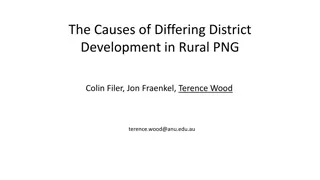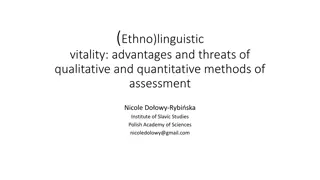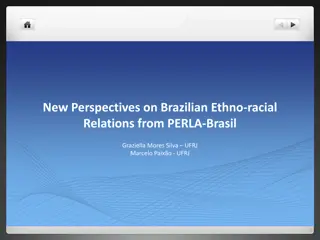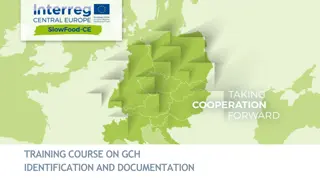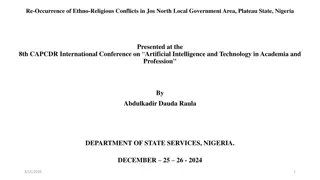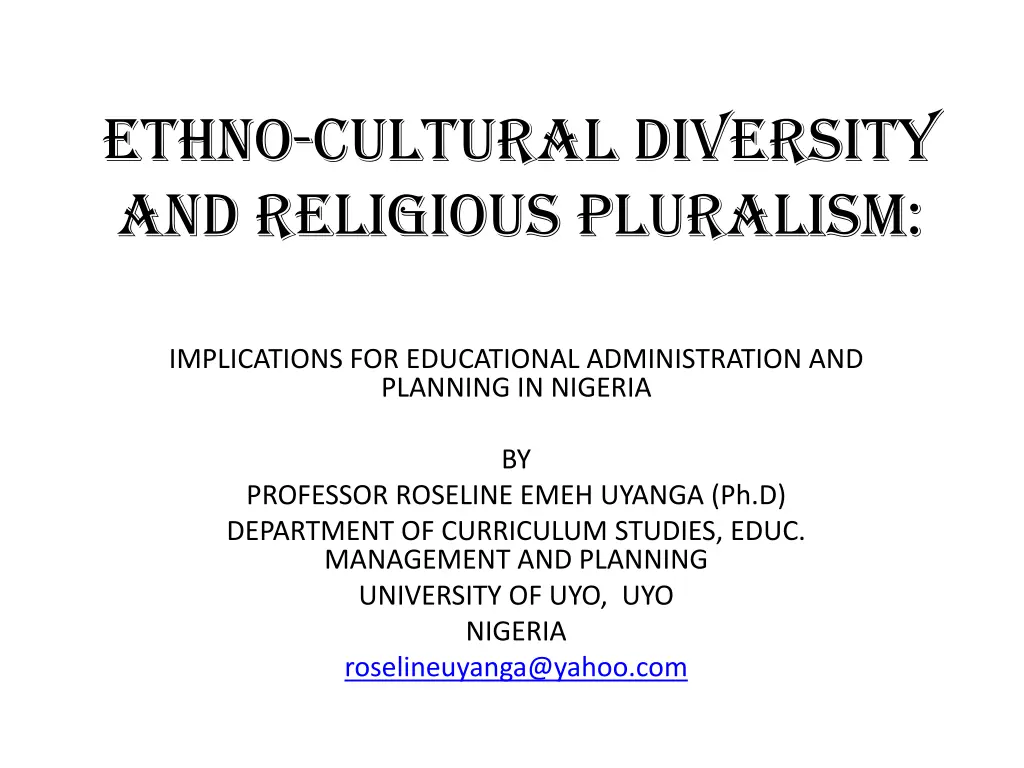
Implications of Ethno-Cultural Diversity and Religious Pluralism on Educational Administration in Nigeria
Explore the challenges arising from ethno-cultural diversity and religious pluralism in Nigeria, focusing on inter-community conflicts, internal displacement, and the impact on educational planning. The study delves into the theory of migration, as well as conflicts and crises leading to internal displacement of persons, shedding light on the need for tolerance and understanding for harmonious co-existence.
Download Presentation

Please find below an Image/Link to download the presentation.
The content on the website is provided AS IS for your information and personal use only. It may not be sold, licensed, or shared on other websites without obtaining consent from the author. If you encounter any issues during the download, it is possible that the publisher has removed the file from their server.
You are allowed to download the files provided on this website for personal or commercial use, subject to the condition that they are used lawfully. All files are the property of their respective owners.
The content on the website is provided AS IS for your information and personal use only. It may not be sold, licensed, or shared on other websites without obtaining consent from the author.
E N D
Presentation Transcript
ETHNO-CULTURAL DIVERSITY AND RELIGIOUS PLURALISM: IMPLICATIONS FOR EDUCATIONAL ADMINISTRATION AND PLANNING IN NIGERIA BY PROFESSOR ROSELINE EMEH UYANGA (Ph.D) DEPARTMENT OF CURRICULUM STUDIES, EDUC. MANAGEMENT AND PLANNING UNIVERSITY OF UYO, UYO NIGERIA roselineuyanga@yahoo.com
FOCUS OF THE STUDY Inter- community conflicts Internal displacement of persons (IDPs) Loss of lives and livelihoods Ethnic and religious identities of IDPs and influence on education
THEORY Lee s theory of migration (1966) Positive / pull factors comprising attractive socio-economic conditions, security and comfort Negative/push factors including poor socio- economic conditions, conflicts, wars, natural disasters and others
MOVEMENTS AND ASSOCIATED CHALLENGES Movements bring diverse groups of persons together, hence the need for self understanding and tolerance for co-existence. Nigeria has over 450 ethnic groups living in 774 local government areas. Nigeria has three major tribes namely: Ibo, Yoruba and Hausa. Nigeria has three major religions namely: Christianity, Islamism and Paganism. Hence: Religious intolerance, Ethnic rivalry, Clash of cultural interest, Struggle for resource control, Struggle for governance.
CONFLICTS AND CRISES LEADING TO INTERNAL DISPLACEMENT OF PERSONS Boundary/ cross border crises (Ebonyi- Cross River, Benue Taraba, Kogi-Edo and Cross River- Akwa Ibom states) Ethno-religious crises (Maitasine riots in Kano, Kaduna, Yola , Maiduguri,Gombe, Bauchi, the Zango-Kataf, Kaduna, Zaria, Katsina and Bauchi crisis etc., Boko Haram) Inter-group crises (Jos civil disturbances, Tiv- Fulani clashes in Benue, Niger delta disturbances, Tiv- Jukun crisis in Benue and Taraba state, etc.)
TABLE 1: Summary of IDPs spread across Nigeria, 2003-2007. S/N States causes Year No of IDPs 1. Yobe Flood/Fire 2003-2007 300,000 2. Jigawa Flood/desertstorm Persistent 200,000 3. Delta Indigene-settlers/economic neglect Persistent 500,000 4. Cross River Communal/land dispute/Bakassicrisis 2003-2007 250,000 5. Plateau Indigene-settlers/Religious conflict Persistent 505,000 6. Osun (Ife-Modakeke) Indigene-settlers 2003 200,000 7. Kano Ethno-religious Persistent 300,000 8. Kwara Ethno-religious 2005 160,000 Source: The Punch, Mon. Feb 22, 2010,p.8 Associated challenges are: inability to provide education to IDPs; dis-unity in the nation. Study investigated these challenges.
TABLE 2: Figures of IDPs in camps during Jan.-Feb. 2010 Ethno-religious crisis within Jos City S/N No of Persons Location of Camps 1. 3,000 NLEA Training centre,Lamingo 2. 2,500 Police Staff College, Bukuru 3. 2,000 Airforce Base, Rayfield 4. 1,450 Multi-Troups Training Centre 5. 3,000 GOC,Rukuba Barracks, Jos 6. 3,000 COCIN, Catholic, Baptist and Ruban Primary Schools 7. 6,000 Bukuru Police B Division 8. 3,000 Central Mosque Source: The Punch, Mon. Feb 22, 2010, p.8
RESEARCH QUESTIONS AND HYPOTHESIS The following research questions guided the study: 1. What are the prevalent factors that pre-dispose to internal displacement of persons in Nigeria? 2. What are the adaptive strategies of educational administrators and planners regarding use of school plant facilities for IDP youths? 3. What are the economic leverage strategies adopted by the educational administrators and planners for IDPs? 4. What integration strategies are adopted by the educational administrators and planners for national unity? Null hypothesis (Ho): There is no significant difference in the mean responses of male and female IDPs on the prevalent factors that pre-dispose to internal displacement of persons in Nigeria.
METHODOLOGY A purposive sampling technique was adopted (Plateau, Cross River and Yobe states in Nigeria) Sample comprised 200 IDPs in the age bracket of 11-30 years, and 40 educational administrators Data collection was with a researcher- designed questionnaire which covered the main areas addressed by the research questions. Descriptive statistics were used to answer research questions, and a t- test of no significant difference was used to test the hypothesis.
RESEARCH QUESTION 1 AND TABLE 4 What are the prevalent factors that pre-dispose to internal displacement of persons in Nigeria? Table 4: Prevalent factors and IDPs in Nigeria Questionnaire Item Factor Very Often Often Occasionally Rarely Very rarely Sum Number of 3 Competitive resource use conflict 133 65 5 - - 200 97.5% 2.5% - 100% 2 Boko insurgency Haram 140 56 4 - - 200 98.0% 2% - 100% 4 Natural disasters 126 48 20 6 - 200 87% 10% 3% 100%
RESEARCH QUESTION 2 AND TABLE 5 What are the adaptive strategies of educational administrators and planners regarding use of school plant facilities for IDPs? Table 5: Ranking of Administrators mean responses to adaptive strategies Questionnair e Item 10 Adaptive strategies Mean Response Rank Over-crowding of nearby community schools 3.78 1st 8 Use of open-air classrooms for learning Use of zana classrooms for learning Use of logs of wood , stones and bare floor as classroom seats Recruitment of additional classroom teachers 3.75 2nd 14 3.12 3rd 9 2.89 4th 12 2.18 5th 5 Use of village council halls as schools Engagement of displaced teachers to teach IDPs 2.12 6th 7 1.93 7th 11 Establishment of camp site schools for IDPs Use of shifting school system to accommodate IDPs Use of school on wheels to cater for IDPs 0.96 8th 6 0.89 9th 13 0.43 10th
RESEARCHQUESTION 3 AND TABLE 6 What are the economic leverage strategies adopted by the educational administrators and planners? Table 6: Ranking of mean responses of IDPs to economic leverage strategies Questionnaire Items Question Mean Rank 18 No specific economic leverage activities are promoted in the camps 2.67 1st 17 Qualified internally displaced teachers are not recognized by Government 2.58 2nd 16 There is temporary employment for qualified teachers in host communities schools 0.96 3rd 15 There is skills training for IDPs in re-location camps 0.83 4th 19 Rural business training is promoted for IDPs in the camps, and in the Host community 0.72 5th
RESEARCH QUESTION 4 AND TABLE 7 What are the functional integration strategies adopted by the government? Table 7: Ranking of administrators mean responses to functional integration strategies Questionnaire Items 21 Question Mean Ranking 1st Singing of the national anthem Recitation of the national pledge Establishment of unity secondary schools 3.87 2nd 24 3.85 3rd 26 3.52 4th 30 Promotion of National Youth Service Corps (NYSC) Programme for university graduates 3.43 5th 27 Equitable facilities to all states in the federation distribution of educational 2.53 6th 25 Promotion of Universal Basic education (UBE) 2.31 7th 22 Promotion of policies on teachers and students exchange programmes 2.07 8th 28 Promotion of non-discriminatory admission policies into educational institutions 2.00 9th 23 Promotion of un-biased appointment to posts of responsibility irrespective of states of origin 1.65 10th 29 Provision of pensionable employment to Nigerians outside their states of origin 1.04
HYPOTHESIS AND TABLE 8 Null hypothesis (Ho): There is no significant difference in the mean responses of male and female IDPs on the prevalent factors that pre-dispose to human displacement in Nigeria. Table 8: t-test on views of IDPs on the prevalent factors that pre-dispose to human displacement based on gender Subjects N Mean SD Cal. T Tab. T Decision Male IDPs 127 39.81 16.05 0.4 1.96 Upheld Female IDPs 73 40.78 17.04
CONCLUSION AND RECOMMENDATIONS Internal displacement of persons is a very common phenomenon in Nigeria. The most prevalent factor that causes internal displacement of persons as indicated in this study, is the Boko Haram insurgency. This is followed by competitive resource use conflict which includes though is not limited to: land use crisis, ethnic rivalry and boundary adjustment crisis, resource control, and struggle for governance crises. Other factors include natural disasters like flood. i. ii. Internal displacement of persons affects school plant facilities management. Educational administrators and planners in Nigeria are doing very little to provide education to IDPs of school age. No specific economic leverage activities like skills training, are planned for IDPs. Integration strategies adopted by both education managers and the Nigerian government are inadequate as unifying factors for the nation, hence the need for additional strategies such as: Provision of functional basic education; promotion of social integration through education, appointment to posts of responsibilities, governance/ leadership, scholarships, employments etc. without bias, and religious tolerance. IDPs should be taken care of educationally, so as to sustain their psyche and personality, and build their capacity for futuristic living .

